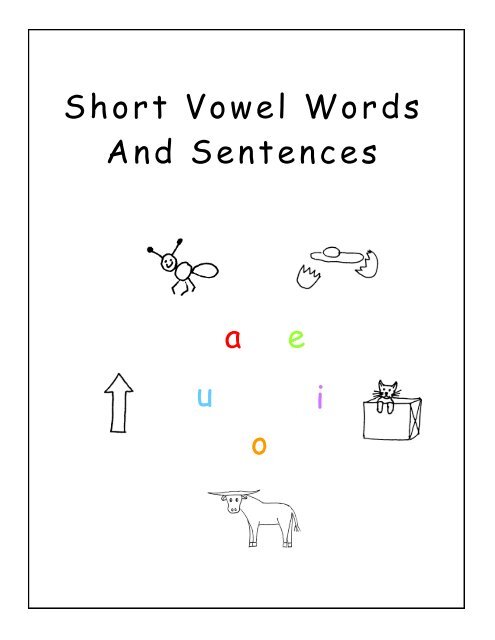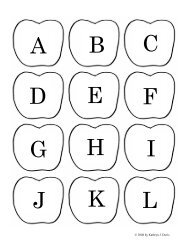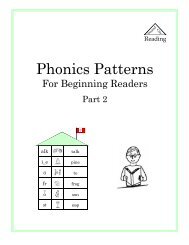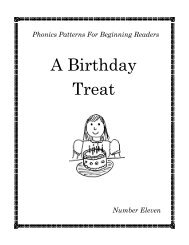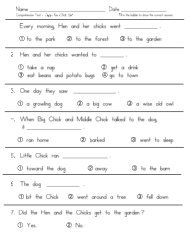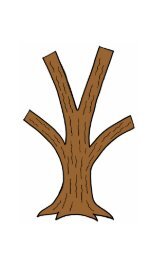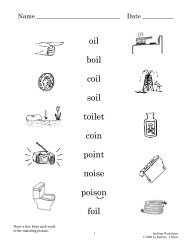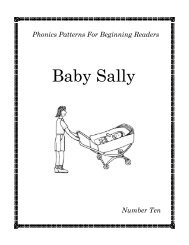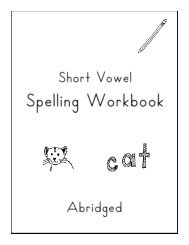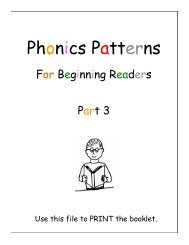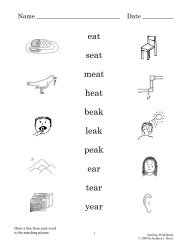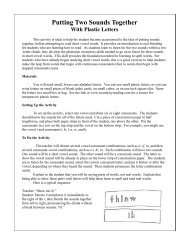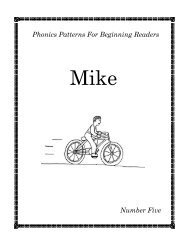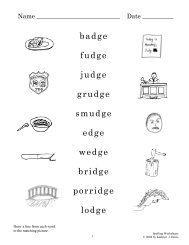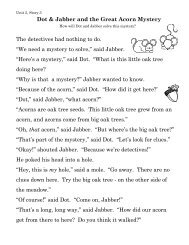Short Vowel Words And Sentences a i o u e - Sound City Reading
Short Vowel Words And Sentences a i o u e - Sound City Reading
Short Vowel Words And Sentences a i o u e - Sound City Reading
You also want an ePaper? Increase the reach of your titles
YUMPU automatically turns print PDFs into web optimized ePapers that Google loves.
<strong>Short</strong> <strong>Vowel</strong> <strong>Words</strong><br />
<strong>And</strong> <strong>Sentences</strong><br />
u<br />
a<br />
o<br />
e<br />
i
Sight Word Review<br />
z<br />
z<br />
a is as I<br />
z<br />
z<br />
A his has<br />
z<br />
was<br />
<strong>Short</strong> <strong>Vowel</strong> <strong>Sound</strong>s<br />
A a E e I i O o U u<br />
Entire contents © 2010 By Kathryn J. Davis<br />
7223 Cedar Lane Drive<br />
Germantown, TN 38138<br />
(901) 737-4466<br />
All rights reserved.<br />
Permission is hereby granted to teachers, parents, and tutors to reproduce<br />
student materials in this book for individual or classroom use. Permission is<br />
granted for school-wide reproduction of materials. Commercial reproduction is<br />
prohibited.<br />
Printed in the United States of America<br />
<strong>Sound</strong><br />
<strong>City</strong><br />
<strong>Reading</strong>
Table of Contents<br />
How to use this book ................................................................................................ 4<br />
The Robot Game ........................................................................................................ 6<br />
Putting Two <strong>Sound</strong>s Together Using Plastic Letters ....................................... 8<br />
<strong>Sound</strong> Blending - Decoding Two <strong>Sound</strong>s ............................................................. 11<br />
The Blueberry and Raspberry Games ................................................................. 14<br />
Using Plastic Letters To Spell Three Letter <strong>Words</strong> ..................................... 15<br />
Learning To Separate <strong>Words</strong> Into <strong>Sound</strong>s ....................................................... 16<br />
<strong>Short</strong> A <strong>Words</strong><br />
<strong>Short</strong> a words, part 1 (continuous consonants at the beginning) ............... 18<br />
<strong>Short</strong> a words, part 2 (stopped consonants at the beginning) .................... 20<br />
Sight word: a ........................................................................................................... 22<br />
Sight word: has....................................................................................................... 26<br />
Sight word: was ...................................................................................................... 30<br />
<strong>Short</strong> I <strong>Words</strong><br />
<strong>Short</strong> i words, part 1 (continuous consonants at the beginning) ................ 34<br />
<strong>Short</strong> i words, part 2 (stopped consonants at the beginning)..................... 36<br />
Sight word: I ........................................................................................................... 38<br />
Sight word: is .......................................................................................................... 42<br />
Sight word: his ....................................................................................................... 44<br />
Statements .............................................................................................................. 46<br />
Questions ................................................................................................................. 48<br />
<strong>Short</strong> O <strong>Words</strong><br />
<strong>Short</strong> o words, part 1 (continuous consonants at the beginning) ............... 50<br />
<strong>Short</strong> o words, part 2 (stopped consonants at the beginning) .................... 52<br />
<strong>Short</strong> U <strong>Words</strong><br />
<strong>Short</strong> u words, part 1 (continuous consonants at the beginning) ............... 62<br />
<strong>Short</strong> u words, part 2 (stopped consonant at the beginning)...................... 64<br />
Suffix study: _s with verbs ................................................................................ 72<br />
<strong>Short</strong> E <strong>Words</strong><br />
<strong>Short</strong> e words, part 1 (continuous consonants at the beginning) ............... 74<br />
<strong>Short</strong> e words, part 2 (stopped consonants at the beginning) ................... 76<br />
Suffix study: _s with verbs ................................................................................ 84<br />
Suffix study: _s with nouns ................................................................................ 90<br />
Suffix study: using 's ........................................................................................... 96<br />
Alphabet Chart ...................................................................................................... 100<br />
Consonant Chart for sound blending activity ................................................. 104<br />
© 2011 by Kathryn J. Davis 3<br />
<strong>Short</strong> <strong>Vowel</strong> <strong>Words</strong> <strong>And</strong> <strong>Sentences</strong>
How To Use This Book<br />
1. Use the sound story at www.soundcityreading.com to introduce the sound pictures.<br />
These pictures provide a visual cue to remind the student of the sound for each letter.<br />
2. Students should be able to recognize and give the sounds for the letters of the<br />
alphabet. Use the alphabet chart to review the letter sounds.<br />
3. In this booklet, students will read words and sentences with each short vowel sound.<br />
The vowel being studied is shown at the top of the page along with the related sound<br />
picture and a key word beginning with that sound. Have students identify this vowel<br />
sound before reading each page.<br />
4. When learning a new set of words, students will see a picture page beside a page of<br />
words. The pictures and words are not in the same order. This allows the teacher to<br />
play the Robot Game with the students who are getting ready to read the words for the<br />
first time. See the instructions in this book.<br />
5. After playing the Robot Game, students will practice decoding (sounding out) new words<br />
in two columns. In the left column, the words are separated, to show the separate<br />
sound units within the word. To read this column, students should put a finger under<br />
the first letter, say the sound, slide their fingers to the next letter, say the sound,<br />
slide to the next letter, and say the sound. Then students should point to the same<br />
word in the right hand column, and pronounce it smoothly. Beginners may prefer to read<br />
the first column only. After reading each word, students may to point to the matching<br />
picture.<br />
6. After reading all the words for each short vowel section, students will read sentences<br />
containing short vowel words. It is not necessary for students to guess. If a student<br />
has trouble with a word, help him to say the sounds from left to right. Also, remind<br />
students to think about the other words in the sentence and anticipate what words<br />
would make sense.<br />
7. Each set of sentences is shown in two different fonts. The vowels are color coded in<br />
the first set, making the material easier to read. All of the letters are black in the<br />
second set. Students should practice until they can read both types of print<br />
comfortably.<br />
8. Explain the use of periods and question marks.<br />
9. There are several pages showing the use of _s with verbs and nouns, and the use of ’s<br />
to show possession. Explain the use of these suffixes and have the student read the<br />
pages.<br />
© 2011 by Kathryn J. Davis 4<br />
<strong>Short</strong> <strong>Vowel</strong> <strong>Words</strong> <strong>And</strong> <strong>Sentences</strong>
10. An umbrella over a vowel is a signal to use the u/umbrella sound (short u sound) for<br />
that vowel, instead of its usual sound.<br />
11. Sight words have parts that can not be sounded out in the usual way. On each sight<br />
word page, show the student how to pronounce the sight words, and have the student<br />
read the sentences. After finishing this booklet, students should be able to read all<br />
of the sight words on the inside of the front cover.<br />
12. The short vowel words are taught in this order: short a words, short i words, short o<br />
words, short u words, short e words. Each set of these is divided into two groups.<br />
The first group of words starts with continuous consonants. The second group of<br />
words starts with stopped consonants.<br />
13. When you pronounce a continuous consonant, it is possible to hold the sound for a<br />
period of time. This makes it much easier for a student to connect the first<br />
consonant sound in the word to the vowel sound that comes after it. I use these<br />
consonants in the first group: f, h, l, m, n, qu, r, s, v, w, x, y, and z. (When you<br />
pronounce the consonants qu and x, you can actually hear two parts to the sound. The<br />
letter qu sounds like /kw/, and the letter x sounds like /ks/. I include these letters<br />
in the continuous consonants since the second part of the sound can be held.)<br />
14. Stopped consonants cannot be held. The sound disappears after you pronounce it. I<br />
use these stopped consonants: b, c, d, g, j, k, p, and t. These words are harder for<br />
beginners to read because it is more difficult to connect the sound of the first<br />
consonant and the following vowel smoothly.<br />
15. I’ve put words that begin with the same consonant together on the page. For<br />
example, the words can, cat, cab, and cap will appear together. This repetition helps<br />
the student master oral blending of the first consonant and the following vowel. It<br />
also helps the student learn to watch carefully and be aware of the ending<br />
consonants, since they change from one word to the next.<br />
16. Beginning readers master decoding skills at different rates. It is important for<br />
students to take ownership over the need to practice reading and rereading the<br />
material until it can be read smoothly, with good expression. Many students have<br />
difficulty getting started, but go on to master the material very well.<br />
17. If a student has difficulty connecting the separate letter sounds together to form<br />
words, play the games suggested in this book on a regular basis. The blueberry and<br />
raspberry games will be available at www.soundcityreading.com.<br />
18. A workbook is available for written practice with short vowel words.<br />
© 2011 by Kathryn J. Davis 5<br />
<strong>Short</strong> <strong>Vowel</strong> <strong>Words</strong> <strong>And</strong> <strong>Sentences</strong>
Playing The Robot Game:<br />
Connecting <strong>Sound</strong>s<br />
To Make <strong>Words</strong><br />
Use the picture pages in this book to play a guessing game to prepare students<br />
to read new words. The pictures are on the left side, and the new words to read are<br />
on the right side. The pictures and words match, but they are not in the same order.<br />
This makes it easier to play the game. During the game, the teacher will say the words<br />
"like a robot," by pronouncing each sound in the word separately.<br />
This activity is ideal to help the student become accustomed to the idea of putting<br />
sounds together to form words. It is ideal for beginners or students who are having<br />
difficulty learning to read.<br />
Part One - Finding the Pictures<br />
1. The student looks at the pictures. The teacher looks at the words.<br />
c......a......t<br />
2. The teacher says the sounds in the first word, going from left to right, with a<br />
pause between each sound. For example, if the word is fan, the teacher would say<br />
"f.......a.......n." Don't point to the letters, just say the sounds. Be sure each sound<br />
is completely separate. For example, don't say "fa......n" or "f.....an." Also, be careful<br />
not to add the "uh" sound to the consonants, "fuh.....a.....nuh." Be sure to pronounce<br />
double letters as a single sound, for example "m......i.......ss."<br />
3. The student looks at all of the pictures, finds the picture of the fan, points to it,<br />
and says the word in the normal way (not with separated sounds).<br />
4. The teacher says the sounds for the next word, and then the remaining words, one<br />
at a time, until all have been completed.<br />
5. The student responds in the same way each time, finding the picture, pointing to it,<br />
and saying the word.<br />
© 2011 by Kathryn J. Davis 6<br />
<strong>Short</strong> <strong>Vowel</strong> <strong>Words</strong> <strong>And</strong> <strong>Sentences</strong>
Part Two - Finding the <strong>Words</strong><br />
1. This time, both the student and the teacher look at the words.<br />
2. The teacher says each word "like a robot," just as before, except this time goes<br />
out of order, selecting words randomly on the page.<br />
3. The student looks at all of the words on the page, listens to the sounds, and finds<br />
the matching word. He must look carefully to find the word with the correct beginning,<br />
middle, and ending sound. Then the student points to the word and says it<br />
in the regular way. If the student tries to say the separate sounds, remind him to<br />
"say it fast."<br />
Comments<br />
This exercise introduces new vocabulary to the students without the burden of<br />
having to decode new words, allowing them to focus on meaning. It also helps students<br />
learn to hear the separate sounds in each word, and then stick them together<br />
to reassemble the word. This is an important skill that develops a student's ability to<br />
spell and decode new words.<br />
(Note: The pages from the pdf file for this book will be available at<br />
www.soundcityreading.com. They can be displayed on a large screen using a projector.<br />
The game can be played with the entire class from the screen.)<br />
© 2011 by Kathryn J. Davis 7<br />
<strong>Short</strong> <strong>Vowel</strong> <strong>Words</strong> <strong>And</strong> <strong>Sentences</strong>
Putting Two <strong>Sound</strong>s Together<br />
Using Plastic Letters<br />
This activity is ideal to help the student become accustomed to the idea of<br />
putting sounds together. It is ideal for beginners or students who are having<br />
difficulty learning to read.<br />
Materials<br />
You will need some system of small, moveable alphabet letters. Use lower case<br />
letters. You can use small plastic letters. Or you can write letters on small pieces of<br />
blank index cards, on small cubes, or on one inch square tiles. Write one letter of the<br />
alphabet on each card, cube, or tile. Store the items in a small box or bag.<br />
Setting Up the Activity<br />
To set up the activity, select one vowel and about six or more consonants. Pick<br />
out letters that have been taught. Cut a piece of construction paper in half<br />
lengthwise, and place both paper strips in front of the student, one above the other.<br />
Put the consonants in a row on the top strip and the vowel on the bottom strip. For<br />
example, you might use the vowel i and consonants t, h, l, n, w, and b.<br />
To Do the Activity<br />
The teacher will dictate several vowel-consonant combinations, such as it, il,<br />
in, etc. Each combination will have two sounds. One sound will be a vowel sound. The<br />
other sound will be a consonant sound. The letter to show the vowel sound will be<br />
already in place on the lower strip of construction paper. The student is to listen for<br />
the consonant sound, select the correct consonant letter, and put it beside the vowel.<br />
Then the student pronounces the letter combination orally.<br />
Explain to the student that you will be saying parts of words, not real words.<br />
We can call these "silly sounds." Explain that being able to spell these parts will help<br />
them learn to spell and read real words.<br />
Be sure to use the short vowel sounds when you do this exercise: a/ant, e/egg,<br />
i/in, o/ox, u/up.<br />
You can see a typical sequence on the next page.<br />
© 2011 by Kathryn J. Davis 8<br />
<strong>Short</strong> <strong>Vowel</strong> <strong>Words</strong> <strong>And</strong> <strong>Sentences</strong>
Teacher: “Show me ib.”<br />
Student: Selects b and places it immediately to the right of the i, then blends the<br />
sounds together from left to right, without a break between sounds: “ib.”<br />
Teacher: “Show me il.”<br />
Student: Puts b back in line above the i, selects l, and places it to the right of i. Blends<br />
the sounds together from left to right: il. (Notice you are not spelling the word ill, just<br />
the work chunk il.)<br />
Teacher: “Show me in.”<br />
Student: Puts b back in line above the i, selects n, and places it to the right of the i.<br />
Says in. (This just happens to be a real word. The student may or may not notice this.)<br />
Teacher: “Show me it.<br />
The teacher and student continue in the same way until all of the possible vowelconsonant<br />
combinations have been done. You won’t use h or w after the i, since ih and<br />
iw are difficult to pronounce and these combinations are not normally seen in words.<br />
You will use the letters h and w shortly as beginning sounds are paired with i.<br />
Next do the same activity, but this time say letter combinations that have the<br />
consonant sound first. Show me hi. Show me bi, ti, li, ni, etc. Don't forget to use the<br />
short vowel sound for all letter combinations.<br />
© 2011 by Kathryn J. Davis 9<br />
<strong>Short</strong> <strong>Vowel</strong> <strong>Words</strong> <strong>And</strong> <strong>Sentences</strong>
This process of building two-letter sound combinations helps students "break the<br />
code" and understand that speech is made up of smaller sounds. Instead of starting<br />
with three-letter words, its much easier for students to just concentrate on two<br />
sounds at a time. Being able to see the letters and physically move them as they hear<br />
the combined sounds and build them opens the door to a real understanding of the<br />
structure of words.<br />
Comment<br />
I worked with my niece years ago when she was in kindergarten. She worked<br />
hard to learn her alphabet letters. At first she couldn’t remember which was which<br />
and couldn’t remember the sounds. I wrote the sound story (available on the website)<br />
for her, and using posters with the letters and sound pictures, she learned those<br />
letters like a pro. But she still did not grasp the concept that the letter sounds could<br />
be put together to form meaningful words. One day, as I was trying to teach her to<br />
build three letter words with plastic letters with no luck, we invented this activity<br />
together. Doing just two sounds at a time made a huge difference. The light bulb went<br />
on during the lesson. From then on she made steady progress, and went on to make<br />
straight A’s in first grade. She is now doing well in her Honor’s reading classes in<br />
middle school, and most important, she loves to read.<br />
© 2011 by Kathryn J. Davis 10<br />
<strong>Short</strong> <strong>Vowel</strong> <strong>Words</strong> <strong>And</strong> <strong>Sentences</strong>
<strong>Sound</strong> Blending - Decoding Two <strong>Sound</strong>s<br />
After the student has practiced putting two sounds together using plastic<br />
letters, you can do this activity to teach the reverse skill. This activity is more<br />
challenging, since the student is going from symbol to sound instead of sound to<br />
symbol. The student must look at a pair of letters and say both sounds, sliding the<br />
sounds together smoothly. The student learns to connect symbols with speech.<br />
Materials<br />
To do this exercise, you can use the sound blending materials available on this<br />
site, or create your own.<br />
You’ll need two separate cards for each vowel, like the i cards shown below.<br />
You will use these cards with two columns of consonants. These materials use large<br />
print so they can be used with a group.<br />
Print the two consonant columns on white cardstock. I print the vowels on<br />
colored cardstock, using red for a, light green for e, light purple for i, orange for o,<br />
light blue for u. Put the two consonant columns on an easel or clip to a pocket chart<br />
or chalkboard.<br />
Setting Up the Activity<br />
You will use two vowel cards and the consonant strips. You will hold a vowel card to<br />
the right or left of each consonant and move the card down the column.<br />
To Do the Activity<br />
Take the vowel you want to work with, and slide it down one side of the<br />
column. Students will blend the sounds for each letter pair aloud. You can go down<br />
the left side first and then the right, or the other way around. If you are using i<br />
on the left side first, the student would watch carefully as you move the i from one<br />
letter to the next and say, “ib, ic, id, if, ig, (skip h), ij, ik, il, im, in, ip, (skip qu and r),<br />
is, it, iv, (skip w), ix, (skip y), iz.” Then, as you move the other vowel card down the<br />
right side of each column, the student would say, “bi, (skip c), di, fi, gi, hi, ji, ki, li,<br />
mi, ni, pi, qui, ri, si, ti, vi, wi, (skip x), yi, zi.” After students master the process<br />
with one short vowel, you can repeat the process for the other vowels. Remember<br />
to use just the short vowel sounds for now.<br />
© 2011 by Kathryn J. Davis 11<br />
<strong>Short</strong> <strong>Vowel</strong> <strong>Words</strong> <strong>And</strong> <strong>Sentences</strong>
i b p i<br />
c qu<br />
d r<br />
f s<br />
g t<br />
h v<br />
j w<br />
k x<br />
l y<br />
m z<br />
n<br />
The task is more difficult for beginners than you might think. Some<br />
students catch on quickly, and others find this process quite challenging. If the<br />
student does not catch on quickly, don’t give up. If necessary, model each<br />
combination for the student by pronouncing it clearly, and have the student repeat.<br />
Regular practice will bring more self-assurance for the student. It may take days<br />
of practice before the student is able to put the sounds together independently.<br />
Even though the student is only blending two sounds together, this exercise<br />
prepares students to read three letter words. If a student can’t put two letter<br />
sounds together, it will be impossible to put three or more sounds together to read<br />
a word. This ability to stick letter sounds together to form words when reading,<br />
and the reverse ability, to separate the individual sounds in whole words when<br />
spelling, is the foundation for developing the ability to decode quickly and<br />
confidently.<br />
© 2011 by Kathryn J. Davis 12<br />
<strong>Short</strong> <strong>Vowel</strong> <strong>Words</strong> <strong>And</strong> <strong>Sentences</strong>
Comments<br />
After a move to a new city, I spent some time tutoring before going back to the<br />
classroom full time. I volunteered to work with students in my cousin’s first grade<br />
class. She gave me four to six students to teach in a small group for about an hour<br />
at a time. I was ready to teach them to read short vowel words, but found that<br />
was way beyond what they were able to do. We had to start with beginning and<br />
ending sounds. I was tutoring a little girl at my house, with the same problem. One<br />
day I devised this activity, and she responded well to it, so I brought it to school<br />
to work with my cousin’s group. It was so difficult for them that we worked at it<br />
for several lessons before they could do it themselves. It was so hard for those<br />
children that I asked the school speech teacher if it was appropriate to use with<br />
them, and she approved. After the students mastered this activity, we went on to<br />
read three letter short-vowel words, and they were able to decode them<br />
comfortably. We played a lot of games decoding three letter short vowel words.<br />
By the end of the year they had improved dramatically, and were learning twoletter<br />
phonogram patterns and reading the related sentences and stories.<br />
© 2011 by Kathryn J. Davis 13<br />
<strong>Short</strong> <strong>Vowel</strong> <strong>Words</strong> <strong>And</strong> <strong>Sentences</strong>
The Blueberry and Raspberry Games<br />
After the student has learned to pronounce vowel-consonant and consonant-vowel<br />
combinations (such as ab, ac, ad, and ba, ca, da) in sound blending exercise two, you<br />
can play this game.<br />
Setting Up: Small blue circles (blueberries) or purple circles (raspberries) with<br />
various vowel-consonant and consonant-vowel combinations are used in this activity.<br />
You can use the patterns at <strong>Sound</strong> <strong>City</strong> <strong>Reading</strong> or make your own. A page with the<br />
outline of a blueberry bush is given to each student. The page has a number of<br />
circles on the bush. Before starting the game, cover these circles with the<br />
blueberries or raspberries, letter side up.<br />
How To Play: Students take turns “picking” a blueberry from their bush. If<br />
they can pronounce the vowel-consonant or consonant-vowel combination correctly,<br />
they may place it to the side. If they cannot, the teacher should model, all the<br />
students repeat, and the blueberry is placed back on the bush. The first person to<br />
pick all of his blueberries is the winner.<br />
Comments: I always remind children when working with two-sound combinations that<br />
they are not real words. We call them “silly sounds.” I tell the students that<br />
learning to pronounce these silly sounds will help them be able to read real words.<br />
ta<br />
ba<br />
ha<br />
ga<br />
sa<br />
ca<br />
fa<br />
la<br />
da<br />
ra ja<br />
ax<br />
na<br />
at ag ap<br />
Blueberry Game Raspberry Game<br />
© 2011 by Kathryn J. Davis 14<br />
<strong>Short</strong> <strong>Vowel</strong> <strong>Words</strong> <strong>And</strong> <strong>Sentences</strong><br />
al<br />
ab<br />
av<br />
an<br />
ad<br />
ak<br />
ac<br />
am
Using Plastic Letters To Spell Three Letter <strong>Words</strong><br />
This activity works well with one to six students, or even a whole class if you have<br />
enough sets of letters. Instead of using the whole alphabet at one time, each student will<br />
take about six or eight letters to work with, designated by the teacher. Students spell<br />
words dictated by the teacher with the letters. They do not write the words on paper, which<br />
allows the spelling to proceed rapidly from one word to the next.<br />
Make a list ahead of time of the words you want to teach. Then list all of the letters<br />
that will be needed.<br />
Have the students sit around a table or at their desks. Ahead of time, cut sheets of<br />
construction paper lengthwise to form two pieces. Each student takes two pieces and places<br />
one above the other in front of them on the table. The top sheet is the "letter bank." The<br />
bottom sheet is the spelling area.<br />
Give each student a box with two each of all the alphabet letters. Say the sound of<br />
each letter the students will need, one at a time. When they hear each sound, students<br />
should find the letter needed and place it on the top sheet of construction paper. Explain to<br />
the students that this is their letter bank. When all the needed letters have been placed in<br />
the letter bank, you’re ready to begin.<br />
Say each word slowly and distinctly and coach the students to listen for each sound<br />
and place the letters accordingly from left to right. Model as needed. Each student will<br />
select the letters needed from his own "letter bank," and spell the word in the spelling area.<br />
Check each student’s work and have them listen again and correct as needed. Have students<br />
place the letters back into their letter banks before dictating another word.<br />
After the students become comfortable with the process, go through a number of<br />
words as quickly as the students can spell them.<br />
Sometimes, have the students leave a word that they spelled in their spelling area,<br />
and ask them to change one letter to create a new word. For example, if the student has<br />
spelled cat, say, "Change just the beginning letter to make the word sat." Or say, "Change<br />
the last letter to make the word cap." Or say, "Change the middle letter to make the word<br />
cut." Soon, the students won't need to be cued. Just say a string of words as follows, one<br />
at a time, and have students replace or remove letters as needed to spell the word: cat, can,<br />
fan, fax, tax, ax, ox, box.<br />
This activity greatly enhances the student's phonemic awareness. He is matching<br />
letters with the sounds he hears in words. He is learning to sequence, add, remove, and<br />
substitute sounds in known words to make new words.<br />
Note: Before you do this exercise, first be sure<br />
the students can do the two-letter exercise with<br />
plastic letters, as described on a previous page.<br />
© 2011 by Kathryn J. Davis 15<br />
<strong>Short</strong> <strong>Vowel</strong> <strong>Words</strong> <strong>And</strong> <strong>Sentences</strong>
Materials:<br />
Learning To Separate <strong>Words</strong> Into <strong>Sound</strong>s<br />
(Preparation For Spelling)<br />
Use any of the picture pages in this book that are used to introduce<br />
the short vowel words. This is strictly a sound game; you won't use<br />
any letters. You’ll need three small objects. Colored cubes or teddy<br />
bear counters are available from school supply stores. If these are<br />
not available, you could use other items, such as buttons, dried beans,<br />
bottle caps, etc. Small slips of paper about one inch square will work,<br />
too. For three-sound words, I like to use three different colors, lined<br />
up from left to right in this order - green, yellow, and red. I talk<br />
about the colors on a stoplight with the student. Green means go,<br />
yellow means slow down, and red means stop. When you work with twosound<br />
words, use only two of the objects.<br />
To do the activity:<br />
The teacher points to a picture. Tell the student the word if he<br />
doesn’t recognize the picture. Show the student how to break the<br />
word apart into separate sounds. Say each sound separately. As you<br />
say each sound, push a cube forward about an inch, going from left to<br />
right. Each cube will represent a sound. Have the student repeat the<br />
process with the same word. Be sure the sounds are completely<br />
separate. For example, cat should be c....a.....t, not ca.....t, and not<br />
c.....at. Continue in the same way for each picture. The goal is for the<br />
student to look at a picture, move the cubes, and separate the word<br />
into distinct sounds without help from you. Be sure to explain the<br />
meanings of any unfamiliar words.<br />
© 2011 by Kathryn J. Davis 16<br />
<strong>Short</strong> <strong>Vowel</strong> <strong>Words</strong> <strong>And</strong> <strong>Sentences</strong>
c.....<br />
.....a.......<br />
.....t<br />
© 2011 by Kathryn J. Davis 17<br />
<strong>Short</strong> <strong>Vowel</strong> <strong>Words</strong> <strong>And</strong> <strong>Sentences</strong>
a<br />
© 2011 by Kathryn J. Davis 18<br />
<strong>Short</strong> <strong>Vowel</strong> <strong>Words</strong> <strong>And</strong> <strong>Sentences</strong><br />
A.<br />
B. C. D.<br />
E. F. G.<br />
H. I. J.
1.<br />
2.<br />
3.<br />
4.<br />
5.<br />
6.<br />
7.<br />
8.<br />
9.<br />
10.<br />
a<br />
f a n fan<br />
m a p map<br />
m a n man<br />
s a t sat<br />
s a d sad<br />
h a t hat<br />
h a d had<br />
n a p nap<br />
r a n ran<br />
a dd add<br />
© 2011 by Kathryn J. Davis 19<br />
<strong>Short</strong> <strong>Vowel</strong> <strong>Words</strong> <strong>And</strong> <strong>Sentences</strong>
a<br />
© 2011 by Kathryn J. Davis 20<br />
<strong>Short</strong> <strong>Vowel</strong> <strong>Words</strong> <strong>And</strong> <strong>Sentences</strong><br />
A.<br />
B. C. D.<br />
E. F. G.<br />
H. I. J.
1.<br />
2.<br />
3.<br />
4.<br />
5.<br />
6.<br />
7.<br />
8.<br />
9.<br />
10.<br />
a<br />
c a n can<br />
c a t cat<br />
p a n pan<br />
p a ss pass<br />
b a d bad<br />
b a t bat<br />
g a s gas<br />
d a d dad<br />
j a m jam<br />
t a g tag<br />
© 2011 by Kathryn J. Davis 21<br />
<strong>Short</strong> <strong>Vowel</strong> <strong>Words</strong> <strong>And</strong> <strong>Sentences</strong>
A a<br />
A man<br />
A fan<br />
A van<br />
a ram<br />
a hat<br />
a sax<br />
Sight<br />
<strong>Words</strong><br />
© 2011 by Kathryn J. Davis 22<br />
<strong>Short</strong> <strong>Vowel</strong> <strong>Words</strong> <strong>And</strong> <strong>Sentences</strong>
A a<br />
A man<br />
A fan<br />
A van<br />
a ram<br />
a hat<br />
a sax<br />
Sight<br />
<strong>Words</strong><br />
© 2011 by Kathryn J. Davis 23<br />
<strong>Short</strong> <strong>Vowel</strong> <strong>Words</strong> <strong>And</strong> <strong>Sentences</strong>
A a<br />
1. A man ran.<br />
2. A rat sat.<br />
3. A ram ran.<br />
4. A man had a hat.<br />
5. Sam ran a lap.<br />
6. Max had a nap.<br />
Sight<br />
<strong>Words</strong><br />
© 2011 by Kathryn J. Davis 24<br />
<strong>Short</strong> <strong>Vowel</strong> <strong>Words</strong> <strong>And</strong> <strong>Sentences</strong>
A a<br />
1. A man ran.<br />
2. A rat sat.<br />
3. A ram ran.<br />
4. A man had a hat.<br />
5. Sam ran a lap.<br />
6. Max had a nap.<br />
Sight<br />
<strong>Words</strong><br />
© 2011 by Kathryn J. Davis 25<br />
<strong>Short</strong> <strong>Vowel</strong> <strong>Words</strong> <strong>And</strong> <strong>Sentences</strong>
z<br />
has<br />
1. A man has an ax.<br />
2. Sam has a sax.<br />
3. A man has a van.<br />
4. Nan has a fan.<br />
5. A man has a hat.<br />
Sight<br />
<strong>Words</strong><br />
© 2011 by Kathryn J. Davis 26<br />
<strong>Short</strong> <strong>Vowel</strong> <strong>Words</strong> <strong>And</strong> <strong>Sentences</strong>
z<br />
has<br />
1. A man has an ax.<br />
2. Sam has a sax.<br />
3. A man has a van.<br />
4. Nan has a fan.<br />
5. A man has a hat.<br />
Sight<br />
<strong>Words</strong><br />
© 2011 by Kathryn J. Davis 27<br />
<strong>Short</strong> <strong>Vowel</strong> <strong>Words</strong> <strong>And</strong> <strong>Sentences</strong>
z<br />
has<br />
1. Pam has a pan.<br />
2. Dan has a cat.<br />
3. Pat has a bat.<br />
4. Sam has a cap.<br />
5. Sam has a gap.<br />
Sight<br />
<strong>Words</strong><br />
© 2011 by Kathryn J. Davis 28<br />
<strong>Short</strong> <strong>Vowel</strong> <strong>Words</strong> <strong>And</strong> <strong>Sentences</strong>
z<br />
has<br />
1. Pam has a pan.<br />
2. Dan has a cat.<br />
3. Pat has a bat.<br />
4. Sam has a cap.<br />
5. Sam has a gap.<br />
Sight<br />
<strong>Words</strong><br />
© 2011 by Kathryn J. Davis 29<br />
<strong>Short</strong> <strong>Vowel</strong> <strong>Words</strong> <strong>And</strong> <strong>Sentences</strong>
1. Max was mad.<br />
2. Sam was sad.<br />
3. Nan was at a lab.<br />
4. A cat was fat.<br />
z<br />
was Sight<br />
<strong>Words</strong><br />
© 2011 by Kathryn J. Davis 30<br />
<strong>Short</strong> <strong>Vowel</strong> <strong>Words</strong> <strong>And</strong> <strong>Sentences</strong>
z<br />
was<br />
1. Max was mad.<br />
2. Sam was sad.<br />
3. Nan was at a lab.<br />
4. A cat was fat.<br />
Sight<br />
<strong>Words</strong><br />
© 2011 by Kathryn J. Davis 31<br />
<strong>Short</strong> <strong>Vowel</strong> <strong>Words</strong> <strong>And</strong> <strong>Sentences</strong>
1. Dan was sad.<br />
2. A rat was fat.<br />
3. A cat was bad.<br />
4. Dad was mad.<br />
z<br />
was Sight<br />
<strong>Words</strong><br />
© 2011 by Kathryn J. Davis 32<br />
<strong>Short</strong> <strong>Vowel</strong> <strong>Words</strong> <strong>And</strong> <strong>Sentences</strong>
z<br />
was<br />
1. Dan was sad.<br />
2. A rat was fat.<br />
3. A cat was bad.<br />
4. Dad was mad.<br />
Sight<br />
<strong>Words</strong><br />
© 2011 by Kathryn J. Davis 33<br />
<strong>Short</strong> <strong>Vowel</strong> <strong>Words</strong> <strong>And</strong> <strong>Sentences</strong>
i<br />
© 2011 by Kathryn J. Davis 34<br />
<strong>Short</strong> <strong>Vowel</strong> <strong>Words</strong> <strong>And</strong> <strong>Sentences</strong><br />
A.<br />
B. C. D.<br />
E. F. G.<br />
H. I. J.
1.<br />
2.<br />
3.<br />
4.<br />
5.<br />
6.<br />
7.<br />
8.<br />
9.<br />
10.<br />
i<br />
s i t sit<br />
s i x six<br />
h i ll hill<br />
h i t hit<br />
h i m him<br />
w i n win<br />
f i ll fill<br />
m i ss miss<br />
i n in<br />
i t it<br />
© 2011 by Kathryn J. Davis 35<br />
<strong>Short</strong> <strong>Vowel</strong> <strong>Words</strong> <strong>And</strong> <strong>Sentences</strong>
i<br />
© 2011 by Kathryn J. Davis 36<br />
<strong>Short</strong> <strong>Vowel</strong> <strong>Words</strong> <strong>And</strong> <strong>Sentences</strong><br />
A.<br />
B. C. D.<br />
E. F. G.<br />
H. I. J.
1.<br />
2.<br />
3.<br />
4.<br />
5.<br />
6.<br />
7.<br />
8.<br />
9.<br />
10.<br />
i<br />
b i g big<br />
b i t bit<br />
b i ll bill<br />
k i d kid<br />
k i ss kiss<br />
p i n pin<br />
p i g pig<br />
p i ll pill<br />
t i p tip<br />
d i g dig<br />
© 2011 by Kathryn J. Davis 37<br />
<strong>Short</strong> <strong>Vowel</strong> <strong>Words</strong> <strong>And</strong> <strong>Sentences</strong>
1. I win.<br />
2. I can mix it.<br />
3. I miss him.<br />
4. I hid.<br />
5. I will sip it.<br />
6. I lit it.<br />
I Sight<br />
<strong>Words</strong><br />
© 2011 by Kathryn J. Davis 38<br />
<strong>Short</strong> <strong>Vowel</strong> <strong>Words</strong> <strong>And</strong> <strong>Sentences</strong>
1. I win.<br />
2. I can mix it.<br />
3. I miss him.<br />
4. I hid.<br />
5. I will sip it.<br />
6. I lit it.<br />
I Sight<br />
<strong>Words</strong><br />
© 2011 by Kathryn J. Davis 39<br />
<strong>Short</strong> <strong>Vowel</strong> <strong>Words</strong> <strong>And</strong> <strong>Sentences</strong>
1. I can zip it.<br />
2. I will hit it.<br />
3. I can dig it.<br />
4. I am a kid.<br />
5. I am a pig.<br />
I Sight<br />
<strong>Words</strong><br />
© 2011 by Kathryn J. Davis 40<br />
<strong>Short</strong> <strong>Vowel</strong> <strong>Words</strong> <strong>And</strong> <strong>Sentences</strong>
1. I can zip it.<br />
2. I will hit it.<br />
3. I can dig it.<br />
4. I am a kid.<br />
5. I am a pig.<br />
I Sight<br />
<strong>Words</strong><br />
© 2011 by Kathryn J. Davis 41<br />
<strong>Short</strong> <strong>Vowel</strong> <strong>Words</strong> <strong>And</strong> <strong>Sentences</strong>
1. Jan is ill.<br />
2. Dan is six.<br />
3. Pam is at a dam.<br />
4. A man is in a cab.<br />
5. It is bad.<br />
6. Jill is at a lab.<br />
z<br />
is Sight<br />
<strong>Words</strong><br />
© 2011 by Kathryn J. Davis 42<br />
<strong>Short</strong> <strong>Vowel</strong> <strong>Words</strong> <strong>And</strong> <strong>Sentences</strong>
1. Jan is ill.<br />
2. Dan is six.<br />
3. Pam is at a dam.<br />
4. A man is in a cab.<br />
5. It is bad.<br />
z<br />
is<br />
6. Jill is at a lab.<br />
Sight<br />
<strong>Words</strong><br />
© 2011 by Kathryn J. Davis 43<br />
<strong>Short</strong> <strong>Vowel</strong> <strong>Words</strong> <strong>And</strong> <strong>Sentences</strong>
1. It is his bib.<br />
2. It is his kit.<br />
3. It is his cat.<br />
4. It is his mitt.<br />
5. Dad is in his van.<br />
z<br />
his Sight<br />
<strong>Words</strong><br />
6. Sam will wax his van.<br />
© 2011 by Kathryn J. Davis 44<br />
<strong>Short</strong> <strong>Vowel</strong> <strong>Words</strong> <strong>And</strong> <strong>Sentences</strong>
z<br />
his<br />
1. It is his bib.<br />
2. It is his kit.<br />
3. It is his cat.<br />
4. It is his mitt.<br />
5. Dad is in his van.<br />
6. Sam will wax his van.<br />
Sight<br />
<strong>Words</strong><br />
© 2011 by Kathryn J. Davis 45<br />
<strong>Short</strong> <strong>Vowel</strong> <strong>Words</strong> <strong>And</strong> <strong>Sentences</strong>
1. Bill will fix it.<br />
2. Kim will kiss him.<br />
3. A big pig has a wig.<br />
4. It bit him.<br />
Statements<br />
5. Pam will miss it.<br />
6. Jan did a kip.<br />
© 2011 by Kathryn J. Davis 46<br />
<strong>Short</strong> <strong>Vowel</strong> <strong>Words</strong> <strong>And</strong> <strong>Sentences</strong>
1. Bill will fix it.<br />
2. Kim will kiss him.<br />
3. A big pig has a wig.<br />
4. It bit him.<br />
Statements<br />
5. Pam will miss it.<br />
6. Jan did a kip.<br />
© 2011 by Kathryn J. Davis 47<br />
<strong>Short</strong> <strong>Vowel</strong> <strong>Words</strong> <strong>And</strong> <strong>Sentences</strong>
1. Did Pat dig it?<br />
2. Will Kim win?<br />
3. Did Jim miss?<br />
4. Can it hiss?<br />
5. Is it big?<br />
Questions<br />
6. Did Sam win?<br />
© 2011 by Kathryn J. Davis 48<br />
<strong>Short</strong> <strong>Vowel</strong> <strong>Words</strong> <strong>And</strong> <strong>Sentences</strong>
1. Did Pat dig it?<br />
2. Will Kim win?<br />
3. Did Jim miss?<br />
4. Can it hiss?<br />
5. Is it big?<br />
Questions<br />
6. Did Sam win?<br />
© 2011 by Kathryn J. Davis 49<br />
<strong>Short</strong> <strong>Vowel</strong> <strong>Words</strong> <strong>And</strong> <strong>Sentences</strong>
o<br />
© 2011 by Kathryn J. Davis 50<br />
<strong>Short</strong> <strong>Vowel</strong> <strong>Words</strong> <strong>And</strong> <strong>Sentences</strong><br />
A.<br />
B. C. D.<br />
E. F. G.<br />
H. I. J.
1.<br />
2.<br />
3.<br />
4.<br />
5.<br />
6.<br />
7.<br />
8.<br />
9.<br />
10.<br />
o<br />
h o p hop<br />
h o t hot<br />
m o m mom<br />
m o p mop<br />
l o g log<br />
l o t lot<br />
f o x fox<br />
n o t not<br />
o n on<br />
o ff off<br />
© 2011 by Kathryn J. Davis 51<br />
<strong>Short</strong> <strong>Vowel</strong> <strong>Words</strong> <strong>And</strong> <strong>Sentences</strong>
o<br />
© 2011 by Kathryn J. Davis 52<br />
<strong>Short</strong> <strong>Vowel</strong> <strong>Words</strong> <strong>And</strong> <strong>Sentences</strong><br />
A.<br />
B. C. D.<br />
E. F. G.<br />
H. I. J.
1.<br />
2.<br />
3.<br />
4.<br />
5.<br />
6.<br />
7.<br />
8.<br />
9.<br />
10.<br />
o<br />
p o t pot<br />
p o p pop<br />
j o g jog<br />
j o b job<br />
d o t dot<br />
d o g dog<br />
d o ll doll<br />
g o t got<br />
t o p top<br />
b o x box<br />
© 2011 by Kathryn J. Davis 53<br />
<strong>Short</strong> <strong>Vowel</strong> <strong>Words</strong> <strong>And</strong> <strong>Sentences</strong>
1. Mom will mop.<br />
2. Moss is on a log.<br />
3. It can hop.<br />
<strong>Sentences</strong><br />
4. A man has a rod.<br />
5. Mom is hot.<br />
6. Rob is not hot.<br />
© 2011 by Kathryn J. Davis 54<br />
<strong>Short</strong> <strong>Vowel</strong> <strong>Words</strong> <strong>And</strong> <strong>Sentences</strong>
1. Mom will mop.<br />
2. Moss is on a log.<br />
3. It can hop.<br />
<strong>Sentences</strong><br />
4. A man has a rod.<br />
5. Mom is hot.<br />
6. Rob is not hot.<br />
© 2011 by Kathryn J. Davis 55<br />
<strong>Short</strong> <strong>Vowel</strong> <strong>Words</strong> <strong>And</strong> <strong>Sentences</strong>
<strong>Sentences</strong><br />
1. A bat is on a mat.<br />
2. A hat is on a cat.<br />
3. A tag is on a bag.<br />
4. A cat is on a mat.<br />
5. Mom is mad.<br />
6. A hog is fat.<br />
© 2011 by Kathryn J. Davis 56<br />
<strong>Short</strong> <strong>Vowel</strong> <strong>Words</strong> <strong>And</strong> <strong>Sentences</strong>
<strong>Sentences</strong><br />
1. A bat is on a mat.<br />
2. A hat is on a cat.<br />
3. A tag is on a bag.<br />
4. A cat is on a mat.<br />
5. Mom is mad.<br />
6. A hog is fat.<br />
© 2011 by Kathryn J. Davis 57<br />
<strong>Short</strong> <strong>Vowel</strong> <strong>Words</strong> <strong>And</strong> <strong>Sentences</strong>
<strong>Sentences</strong><br />
1. A dot is on a pot.<br />
2. A dog is on a log.<br />
3. Bob has a box.<br />
4. Bill is on a hill top.<br />
5. A fox got on a box.<br />
6. Rob did his job.<br />
© 2011 by Kathryn J. Davis 58<br />
<strong>Short</strong> <strong>Vowel</strong> <strong>Words</strong> <strong>And</strong> <strong>Sentences</strong>
<strong>Sentences</strong><br />
1. A dot is on a pot.<br />
2. A dog is on a log.<br />
3. Bob has a box.<br />
4. Bill is on a hill top.<br />
5. A fox got on a box.<br />
6. Rob did his job.<br />
© 2011 by Kathryn J. Davis 59<br />
<strong>Short</strong> <strong>Vowel</strong> <strong>Words</strong> <strong>And</strong> <strong>Sentences</strong>
1. A dog is hot.<br />
2. A lid is on a pot.<br />
3. A cat is on a box.<br />
4. Rob can jog.<br />
5. A pot is hot.<br />
6.<br />
<strong>Sentences</strong><br />
Tom has a pot.<br />
Mom has a box.<br />
© 2011 by Kathryn J. Davis 60<br />
<strong>Short</strong> <strong>Vowel</strong> <strong>Words</strong> <strong>And</strong> <strong>Sentences</strong>
1. A dog is hot.<br />
2. A lid is on a pot.<br />
3. A cat is on a box.<br />
4. Rob can jog.<br />
5. A pot is hot.<br />
6.<br />
<strong>Sentences</strong><br />
Tom has a pot.<br />
Mom has a box.<br />
© 2011 by Kathryn J. Davis 61<br />
<strong>Short</strong> <strong>Vowel</strong> <strong>Words</strong> <strong>And</strong> <strong>Sentences</strong>
u<br />
© 2011 by Kathryn J. Davis 62<br />
<strong>Short</strong> <strong>Vowel</strong> <strong>Words</strong> <strong>And</strong> <strong>Sentences</strong><br />
A.<br />
B. C. D.<br />
E. F. G.<br />
H. I. J.
1.<br />
2.<br />
3.<br />
4.<br />
5.<br />
6.<br />
7.<br />
8.<br />
9.<br />
10.<br />
u<br />
r u n run<br />
r u g rug<br />
s u m sum<br />
s u n sun<br />
h u g hug<br />
n u t nut<br />
f u n fun<br />
m u d mud<br />
u p up<br />
u s us<br />
© 2011 by Kathryn J. Davis 63<br />
<strong>Short</strong> <strong>Vowel</strong> <strong>Words</strong> <strong>And</strong> <strong>Sentences</strong>
u<br />
© 2011 by Kathryn J. Davis 64<br />
<strong>Short</strong> <strong>Vowel</strong> <strong>Words</strong> <strong>And</strong> <strong>Sentences</strong><br />
A.<br />
B. C. D.<br />
E. F. G.<br />
H. I. J.
1.<br />
2.<br />
3.<br />
4.<br />
5.<br />
6.<br />
7.<br />
8.<br />
9.<br />
10.<br />
u<br />
b u g bug<br />
b u s bus<br />
b u zz buzz<br />
c u p cup<br />
c u t cut<br />
c u b cub<br />
t u b tub<br />
p u p pup<br />
g u m gum<br />
d u g dug<br />
© 2011 by Kathryn J. Davis 65<br />
<strong>Short</strong> <strong>Vowel</strong> <strong>Words</strong> <strong>And</strong> <strong>Sentences</strong>
1. I can run.<br />
2. Mom will fuss.<br />
3. Pam can hum.<br />
4. Jan has a muff.<br />
5. Jill has fun.<br />
6. It has fuzz.<br />
<strong>Sentences</strong><br />
© 2011 by Kathryn J. Davis 66<br />
<strong>Short</strong> <strong>Vowel</strong> <strong>Words</strong> <strong>And</strong> <strong>Sentences</strong>
1. I can run.<br />
2. Mom will fuss.<br />
3. Pam can hum.<br />
4. Jan has a muff.<br />
5. Jill has fun.<br />
6. It has fuzz.<br />
<strong>Sentences</strong><br />
© 2011 by Kathryn J. Davis 67<br />
<strong>Short</strong> <strong>Vowel</strong> <strong>Words</strong> <strong>And</strong> <strong>Sentences</strong>
<strong>Sentences</strong><br />
1. A pig is in mud.<br />
2. Jan is in a hut.<br />
3. A mug is hot.<br />
4. Jan ran up a hill.<br />
5. Bill will fuss.<br />
6. Sam will hug Tom.<br />
© 2011 by Kathryn J. Davis 68<br />
<strong>Short</strong> <strong>Vowel</strong> <strong>Words</strong> <strong>And</strong> <strong>Sentences</strong>
<strong>Sentences</strong><br />
1. A pig is in mud.<br />
2. Jan is in a hut.<br />
3. A mug is hot.<br />
4. Jan ran up a hill.<br />
5. Bill will fuss.<br />
6. Sam will hug Tom.<br />
© 2011 by Kathryn J. Davis 69<br />
<strong>Short</strong> <strong>Vowel</strong> <strong>Words</strong> <strong>And</strong> <strong>Sentences</strong>
1. Gus is on a bus.<br />
2. A pup is up.<br />
3. A bug is on a rug.<br />
4. Mom cut it.<br />
<strong>Sentences</strong><br />
5. It is his tux.<br />
6. A man dug up a jug.<br />
© 2011 by Kathryn J. Davis 70<br />
<strong>Short</strong> <strong>Vowel</strong> <strong>Words</strong> <strong>And</strong> <strong>Sentences</strong>
1. Gus is on a bus.<br />
2. A pup is up.<br />
3. A bug is on a rug.<br />
4. Mom cut it.<br />
<strong>Sentences</strong><br />
5. It is his tux.<br />
6. A man dug up a jug.<br />
© 2011 by Kathryn J. Davis 71<br />
<strong>Short</strong> <strong>Vowel</strong> <strong>Words</strong> <strong>And</strong> <strong>Sentences</strong>
Suffix Study<br />
_s<br />
1. run s runs<br />
2. sit s sits<br />
3. tap s taps<br />
4. jog s jogs<br />
5. cut s cuts<br />
6. fill s fills<br />
© 2011 by Kathryn J. Davis 72<br />
<strong>Short</strong> <strong>Vowel</strong> <strong>Words</strong> <strong>And</strong> <strong>Sentences</strong>
Suffix Study<br />
_s<br />
1. run s runs<br />
2. sit s sits<br />
3. tap s taps<br />
4. jog s jogs<br />
5. cut s cuts<br />
6. fill s fills<br />
© 2011 by Kathryn J. Davis 73<br />
<strong>Short</strong> <strong>Vowel</strong> <strong>Words</strong> <strong>And</strong> <strong>Sentences</strong>
e<br />
© 2011 by Kathryn J. Davis 74<br />
<strong>Short</strong> <strong>Vowel</strong> <strong>Words</strong> <strong>And</strong> <strong>Sentences</strong><br />
A.<br />
B. C. D.<br />
E. F. G.<br />
H. I. J.
1.<br />
2.<br />
3.<br />
4.<br />
5.<br />
6.<br />
7.<br />
8.<br />
9.<br />
10.<br />
e<br />
s e ll sell<br />
s e t set<br />
l e g leg<br />
l e ss less<br />
w e ll well<br />
y e s yes<br />
m e n men<br />
r e d red<br />
f e ll fell<br />
e gg egg<br />
© 2011 by Kathryn J. Davis 75<br />
<strong>Short</strong> <strong>Vowel</strong> <strong>Words</strong> <strong>And</strong> <strong>Sentences</strong>
e<br />
© 2011 by Kathryn J. Davis 76<br />
<strong>Short</strong> <strong>Vowel</strong> <strong>Words</strong> <strong>And</strong> <strong>Sentences</strong><br />
A.<br />
B. C. D.<br />
E. F. G.<br />
H. I. J.
1.<br />
2.<br />
3.<br />
4.<br />
5.<br />
6.<br />
7.<br />
8.<br />
9.<br />
10.<br />
e<br />
b e d bed<br />
b e ll bell<br />
t e n ten<br />
t e ll tell<br />
d e n den<br />
j e t jet<br />
g e t get<br />
p e g peg<br />
p e n pen<br />
p e t pet<br />
© 2011 by Kathryn J. Davis 77<br />
<strong>Short</strong> <strong>Vowel</strong> <strong>Words</strong> <strong>And</strong> <strong>Sentences</strong>
1. A bag fell.<br />
2. It is a big mess.<br />
3. Tom fell. Tom will yell.<br />
4. Don has less.<br />
5. Meg will sell a fan.<br />
6. It is red.<br />
<strong>Sentences</strong><br />
© 2011 by Kathryn J. Davis 78<br />
<strong>Short</strong> <strong>Vowel</strong> <strong>Words</strong> <strong>And</strong> <strong>Sentences</strong>
1. A bag fell.<br />
2. It is a big mess.<br />
3. Tom fell. Tom will yell.<br />
4. Don has less.<br />
5. Meg will sell a fan.<br />
6. It is red.<br />
<strong>Sentences</strong><br />
© 2011 by Kathryn J. Davis 79<br />
<strong>Short</strong> <strong>Vowel</strong> <strong>Words</strong> <strong>And</strong> <strong>Sentences</strong>
1. Yes, Sam did win.<br />
2. A dog got wet.<br />
3. A man has a fez.<br />
4. Ed fed his dog.<br />
5. Ned met Meg.<br />
6. Jan is a vet.<br />
<strong>Sentences</strong><br />
© 2011 by Kathryn J. Davis 80<br />
<strong>Short</strong> <strong>Vowel</strong> <strong>Words</strong> <strong>And</strong> <strong>Sentences</strong>
<strong>Sentences</strong><br />
1. Yes, Sam did win.<br />
2. A dog got wet.<br />
3. A man has a fez.<br />
4. Ed fed his dog.<br />
5. Ned met Meg.<br />
6. Jan is a vet.<br />
© 2011 by Kathryn J. Davis 81<br />
<strong>Short</strong> <strong>Vowel</strong> <strong>Words</strong> <strong>And</strong> <strong>Sentences</strong>
<strong>Sentences</strong><br />
1. A web is on a bell.<br />
2. Ken is in bed.<br />
3. Ted fed Ned.<br />
4. Bess will get a pet.<br />
5. Ben will not get wet.<br />
6. Jeff is on a jet.<br />
© 2011 by Kathryn J. Davis 82<br />
<strong>Short</strong> <strong>Vowel</strong> <strong>Words</strong> <strong>And</strong> <strong>Sentences</strong>
1. A web is on a bell.<br />
2. Ken is in bed.<br />
3. Ted fed Ned.<br />
<strong>Sentences</strong><br />
4. Bess will get a pet.<br />
5. Ben will not get wet.<br />
6. Jeff is on a jet.<br />
© 2011 by Kathryn J. Davis 83<br />
<strong>Short</strong> <strong>Vowel</strong> <strong>Words</strong> <strong>And</strong> <strong>Sentences</strong>
Suffix Study<br />
_s<br />
1. wag s wags<br />
2. get s gets<br />
3. nod s nods<br />
4. tell s tells<br />
5. hit s hits<br />
6. hug s hugs<br />
© 2011 by Kathryn J. Davis 84<br />
<strong>Short</strong> <strong>Vowel</strong> <strong>Words</strong> <strong>And</strong> <strong>Sentences</strong>
Suffix Study<br />
_s<br />
1. wag s wags<br />
2. get s gets<br />
3. nod s nods<br />
4. tell s tells<br />
5. hit s hits<br />
6. hug s hugs<br />
© 2011 by Kathryn J. Davis 85<br />
<strong>Short</strong> <strong>Vowel</strong> <strong>Words</strong> <strong>And</strong> <strong>Sentences</strong>
Suffix Study<br />
1. Gus runs a lap.<br />
2. Mom hums.<br />
3. Jill runs up a hill.<br />
4. Tim tugs on it.<br />
5. A cat sits on a rat.<br />
6. It pops.<br />
_s<br />
© 2011 by Kathryn J. Davis 86<br />
<strong>Short</strong> <strong>Vowel</strong> <strong>Words</strong> <strong>And</strong> <strong>Sentences</strong>
Suffix Study<br />
1. Gus runs a lap.<br />
2. Mom hums.<br />
3. Jill runs up a hill.<br />
4. Tim tugs on it.<br />
5. A cat sits on a rat.<br />
6. It pops.<br />
_s<br />
© 2011 by Kathryn J. Davis 87<br />
<strong>Short</strong> <strong>Vowel</strong> <strong>Words</strong> <strong>And</strong> <strong>Sentences</strong>
Suffix Study<br />
1. A pet gets wet.<br />
2. Jim dabs it.<br />
3. A cat sits on a van.<br />
4. Meg fills a box.<br />
5. A dog runs.<br />
6. A cat digs.<br />
_s<br />
© 2011 by Kathryn J. Davis 88<br />
<strong>Short</strong> <strong>Vowel</strong> <strong>Words</strong> <strong>And</strong> <strong>Sentences</strong>
Suffix Study<br />
1. A pet gets wet.<br />
2. Jim dabs it.<br />
3. A cat sits on a van.<br />
4. Meg fills a box.<br />
5. A dog runs.<br />
6. A cat digs.<br />
_s<br />
© 2011 by Kathryn J. Davis 89<br />
<strong>Short</strong> <strong>Vowel</strong> <strong>Words</strong> <strong>And</strong> <strong>Sentences</strong>
Suffix Study<br />
_s<br />
1. cat cats<br />
2. dog dogs<br />
3. hill hills<br />
4. cup cups<br />
5. egg eggs<br />
6. kid kids<br />
© 2011 by Kathryn J. Davis 90<br />
<strong>Short</strong> <strong>Vowel</strong> <strong>Words</strong> <strong>And</strong> <strong>Sentences</strong>
Suffix Study<br />
_s<br />
1. cat cats<br />
2. dog dogs<br />
3. hill hills<br />
4. cup cups<br />
5. egg eggs<br />
6. kid kids<br />
© 2011 by Kathryn J. Davis 91<br />
<strong>Short</strong> <strong>Vowel</strong> <strong>Words</strong> <strong>And</strong> <strong>Sentences</strong>
Suffix Study<br />
_s<br />
1. fin fins<br />
2. kid kids<br />
3. pin pins<br />
4. bib bibs<br />
5. pill pills<br />
6. pen pens<br />
© 2011 by Kathryn J. Davis 92<br />
<strong>Short</strong> <strong>Vowel</strong> <strong>Words</strong> <strong>And</strong> <strong>Sentences</strong>
Suffix Study<br />
_s<br />
1. fin fins<br />
2. kid kids<br />
3. pin pins<br />
4. bib bibs<br />
5. pill pills<br />
6. pen pens<br />
© 2011 by Kathryn J. Davis 93<br />
<strong>Short</strong> <strong>Vowel</strong> <strong>Words</strong> <strong>And</strong> <strong>Sentences</strong>
Suffix Study<br />
1. Six kids hid.<br />
2. Gus fed his cats.<br />
3. Ed will pet his dogs.<br />
4. Ten cups fell.<br />
_s<br />
5. Tom ran six laps.<br />
6. Six pigs got wet.<br />
© 2011 by Kathryn J. Davis 94<br />
<strong>Short</strong> <strong>Vowel</strong> <strong>Words</strong> <strong>And</strong> <strong>Sentences</strong>
Suffix Study<br />
1. Six kids hid.<br />
2. Gus fed his cats.<br />
3. Ed will pet his dogs.<br />
4. Ten cups fell.<br />
_s<br />
5. Tom ran six laps.<br />
6. Six pigs got wet.<br />
© 2011 by Kathryn J. Davis 95<br />
<strong>Short</strong> <strong>Vowel</strong> <strong>Words</strong> <strong>And</strong> <strong>Sentences</strong>
Suffix Study<br />
1. Sam's cat<br />
2. Pam's pan<br />
3. Ben's cap<br />
4. Jill's doll<br />
5. Tom's van<br />
6. Meg's dog<br />
_'s<br />
© 2011 by Kathryn J. Davis 96<br />
<strong>Short</strong> <strong>Vowel</strong> <strong>Words</strong> <strong>And</strong> <strong>Sentences</strong>
Suffix Study<br />
1. Sam's cat<br />
2. Pam's pan<br />
3. Ben's cap<br />
4. Jill's doll<br />
5. Tom's van<br />
6. Meg's dog<br />
_'s<br />
© 2011 by Kathryn J. Davis 97<br />
<strong>Short</strong> <strong>Vowel</strong> <strong>Words</strong> <strong>And</strong> <strong>Sentences</strong>
Suffix Study<br />
_'s<br />
1. Jeff will get dad's map.<br />
2. Ben's cap is red.<br />
3. Ed's dog will win.<br />
4. I will wax dad's van.<br />
5. Sam's cat is on his bed.<br />
6. Mom's box is big.<br />
© 2011 by Kathryn J. Davis 98<br />
<strong>Short</strong> <strong>Vowel</strong> <strong>Words</strong> <strong>And</strong> <strong>Sentences</strong>
Suffix Study<br />
_'s<br />
1. Jeff will get dad's map.<br />
2. Ben's cap is red.<br />
3. Ed's dog will win.<br />
4. I will wax dad's van.<br />
5. Sam's cat is on his bed.<br />
6. Mom's box is big.<br />
© 2011 by Kathryn J. Davis 99<br />
<strong>Short</strong> <strong>Vowel</strong> <strong>Words</strong> <strong>And</strong> <strong>Sentences</strong>
These are the consonant and short vowel sounds in alphabetical order. They are printed in the Comic Sans font<br />
with color-coding on the vowels. The pictures are from the <strong>Sound</strong> Story, to help you remember the sounds.<br />
Practice saying each letter sound.<br />
A a B b C c D d E e<br />
F f G g H h I i J j<br />
K k L l M m N n O o<br />
P p Qu qu R r S s T t<br />
u U v V w W x X y Y<br />
U u V v W w X x Y y Z z<br />
© 2011 by Kathryn J. Davis 100 <strong>Short</strong> <strong>Vowel</strong> <strong>Words</strong> <strong>And</strong> <strong>Sentences</strong>
These are the consonant and short vowel sounds in alphabetical order. They are printed in the Century<br />
Schoolbook font. Many books are printed with letters that look like this. The pictures are from the <strong>Sound</strong> Story,<br />
to help you remember the sounds. Practice saying each letter sound.<br />
A a B b C c D d E e<br />
F f G g H h I i J j<br />
K k L l M m N n O o<br />
P p Qu qu R r S s T t<br />
U u U u V v V W w W X x x Y X y y Z Y z<br />
© 2011 by Kathryn J. Davis 101 <strong>Short</strong> <strong>Vowel</strong> <strong>Words</strong> <strong>And</strong> <strong>Sentences</strong>
© 2011 by Kathryn J. Davis 102 <strong>Short</strong> <strong>Vowel</strong> <strong>Words</strong> <strong>And</strong> <strong>Sentences</strong>
© 2011 by Kathryn J. Davis 103 <strong>Short</strong> <strong>Vowel</strong> <strong>Words</strong> <strong>And</strong> <strong>Sentences</strong>
n<br />
c p<br />
d qu<br />
f r<br />
g s<br />
h t<br />
j v<br />
k w<br />
l x<br />
m y<br />
z<br />
© 2011 by Kathryn J. Davis 104 <strong>Short</strong> <strong>Vowel</strong> <strong>Words</strong> <strong>And</strong> <strong>Sentences</strong>


